Are you ready to take your fly-fishing game to the next level? If you are looking for something different, give a try to Euro nymphing, the new fancy in the sport. The European-style technique which is quite different from the conventional nymphing is used by longer rods, delicate leaders, and specific presentation styles.
Intrigued? Nymphing with the Euro style is particularly effective, especially in deeper parts and faster flow. The emphasis on technical aspects like precise fly lifting might make it complicated.
But do not worry, in this article, we will reveal the secrets of a good Euro nymphing setup: from selecting the appropriate equipment to assembling step by step. With this, you can learn how euro nymphing is the secret weapon that could propel your fly-fishing skills to the next level.
What Is Euro Nymphing?
The Euro nymphing is a unique fly-fishing technique that has stemmed from European competition fly fishing where anglers fish in teams and try to catch the most trout possible within a specific time frame.
The technique quickly gained popularity among many trout anglers because it catches fish in any given situation. Euro nymphing employs weighted flies and a long, delicate, sensitive leader to accomplish direct connection with your flies as they float underwater.
This is exactly what allows you to hear not just soft but also very delicate sounds.
History of Euro Nymphing
It all started with European competitive fly fishing by the late 20th century, which later became the groundwork of the Euro nymphing techniques.
Tournaments mostly take place on water that has been pressured before, with trout being spookier than usual. The angler should not only make a flawless cast but also detect the slightest bites.
European anglers developed different tactics to conquer the various landscape challenges; the main priority became thin lines, long leaders, and super heavy flies for better floatation and touch.
Over the years, the majority of these tactics came under one term called “Euro nymphing” and then slowly spread from Europe to the rest of the world where most trout anglers are the ones favoring it.
Differences Between Euro Nymphing and Others
- Traditional Nymphing: Often uses a strike indicator (like a bobber) to show when a fish bites. Euro relies on feeling the line for subtle takes.
- Weighting: Euro nymphs are heavily weighted, often with tungsten beads, to sink quickly and reach the fish. Traditional nymphs might use split shots for weight, adding slack to the line.
- Presentation: Euro focuses on a tight-line presentation, keeping the flies drifting naturally near the bottom. Traditional nymphing can involve letting the flies bob with the current.
Why Choose Euro Nymphing?
Here are the fundamental benefits of why you might choose Euro Nymphing.
1. Super sensitive
The straight connection between you and your flies via a very long, thin leader allows you to feel any slight take, including from trout who could have only nibbled your fly and then let it out of their mouths. This high responsiveness is a great profit, especially when there are pressured waters, and trout are stubborn to strike eagerly.
2. Improved Drift
The weighted flies produce a slower drift, and the tight line presentation adds to that, keeping your fly longer in the strike zone. High lead weight let the nymphs sink fast, and straight-line presentation minimized the slack that made them drag unnaturally. This enables you to display your flies more naturally and with a hint of real-life movement that trout feed on.
3. Spooking
The lightweight gear and lesser-impact area are usually not enough to scare the fish it is hard to be successful. In the euro nymphing, the anglers use thin leaders’ tippet material and small flies. This is everything kept subtle and the minimum profile of the rig on water. Further, narrow line presentation will eliminate flashy casts and drifts which may distract the trout in clear waters.
4. More Accurate Casting
Shorter casts with Euro nymphing allow for pinpoint presentations in tight spots. The long leader and lightweight flies make for delicate presentations, allowing you to cast accurately to specific feeding lanes or seams in the water where trout are likely to be holding. This precision casting is crucial for enticing pressured fish that are accustomed to seeing anglers and avoiding carelessly presented flies.
5. Fish In Different Waters
Effective in both fast-moving currents and slower pools where traditional presentations struggle. The weighted flies and tight line presentation allow Euro nymphing to adapt to different water types. In fast currents, the heavy nymphs can hold the bottom and avoid getting swept downstream, while the tight line presentation keeps them drifting naturally. In slower pools, the weighted flies can still get down to the strike zone, and the angler can control the drift with subtle adjustments to the line.
Is Euro Nymphing Easy Or Hard To Use?
Euro nymphing has a steeper learning curve than traditional methods of fly fishing which rely on a tighter casting loop and shorter lines. The aspect of fine-tuning the tight line presentation and being able to interpret the vagueness goes through the learning process. Although casting involves certain basics that require some learning time, many fishermen find the method enjoyable once they get the hang of it.
What Fishing Conditions Is It Best For?
Clearwater with pressured fish: Euro’s sensitivity is a huge advantage when trout are spooky and less likely to chase flies aggressively.
Variety of water types: From fast currents to slow pools, the weighted flies and tight line presentation can adapt to different flow rates.
Tight quarters: The short casts of Euro nymphing are perfect for fishing narrow streams or around obstacles.
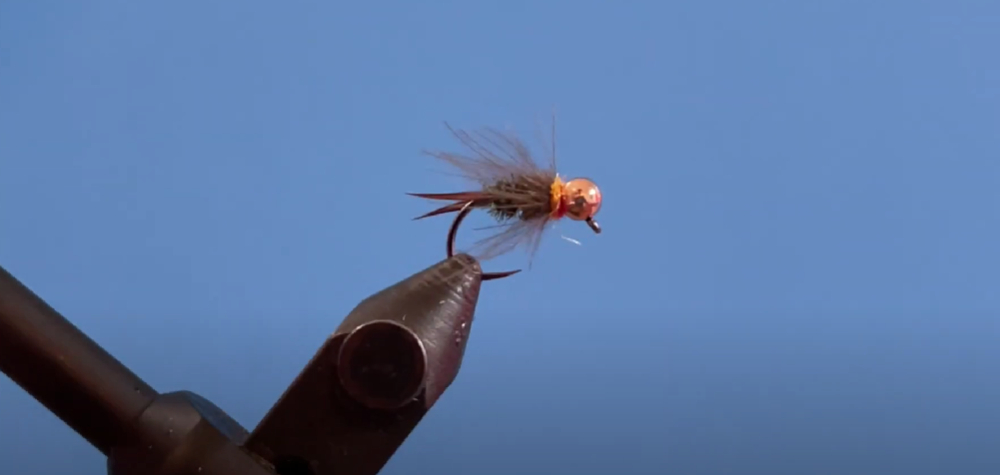
How Does Euro Nymphing Setup Affect Fishing?
In Euro nymphing, an appropriate setup plays an imperious role in increasing efficiency and consequent for fishing experience. Here is how:
Precision and Sensitivity
Euro nymphing setup makes use of a slender leader and extremely lightweight flies to mimic natural drift and detect the most subtle bites. The negative aspects of holding excess leverage can throw off this balance. A rod that is too stiff won’t detect more subtle bites and a leader that is too thick or too short breaks the natural drift and lowers the sensitivity.
Line Control and Casting
Every bit of the water is covered by euro nymphing with tight line methods so that you can get continuous contact with your flies. The correct setting gives the required outlay. A badly balanced reel or line that doesn’t match the weight can complicate the way you handle the line, thus retarding smooth delivery of the flies and natural drift.
Reduced Frustration
When a Euro setup is dialed in, the ensuing frustration is non-existence and no time is lost. For example, a leader with weak knots or tippets which is too light will lead to break-offs and the flies lost. On the contrary, a good knot that will allow for easy replacement of the tippet with a stronger knot while minimizing the chances of failure is the key to covering all the bases.
Overall Enjoyment
The well-adjusted Euro setup improves your fishing experience. Feeling those almost-takes, making precise casts, and leaving tackle problems behind all result in a beautiful time on the water. By that time, you’ll be confident in your presentation and enjoying sparks of excitement inside.
Step-by-Step Guide On Euro Nymphing Setup
Euro nymphing is a precise fly-fishing technique that excels at catching fish in faster currents. Here’s how to get your Euro nymphing setup ready:
Rod and Reel
Rod: Choose a 9-10 foot, 5 or 6-weight fly rod with a medium-fast action. This provides a good feel for delicate presentations and enough power to handle currents.
Reel: A large arbor reel with a good drag system is ideal. You won’t be using a lot of backing, so focus on a smooth drag for playing fish.
Leader and Tippet
French Leader: This is the heart of a Euro setup. You can buy pre-tied leaders or learn to tie your own. It typically consists of a butt section (thicker), followed by decreasing diameters down to a finer tippet.
Tippet Ring (Optional): This allows for quick tippet changes. You can also tie the tippet directly to the leader.
Tippet: Start with 5X or 6X tippet material, 6-8 feet long. You can adjust the length based on water depth and conditions.
Flies
Euro Nymphs: Choose small, bead-head nymphs in sizes 14-18. Popular patterns include Perdigons, Squirmy Worms, and Zebra Midges.
Two-Fly Setup: A common Euro nymphing approach is to fish two flies. Attach one nymph directly to the tippet and another foot or two higher up the leader using a dropper tag.
Tying It All Together
- Attach the Leader: Connect the French leader to the fly line using a loop-to-loop connection or a nail knot (ensure the knot is small enough to pass through the rod guides).
- Tippet Ring (Optional): If using a tippet ring, attach it to the end of the leader.
- Tie the Tippet: If not using a tippet ring, tie the chosen tippet length directly to the leader using a strong knot like the non-slip mono loop knot.
- Attach Flies: Tie your first nymph directly to the tippet end. For the dropper nymph, tie a short dropper tag a foot or two above the leader and attach your second nymph there.
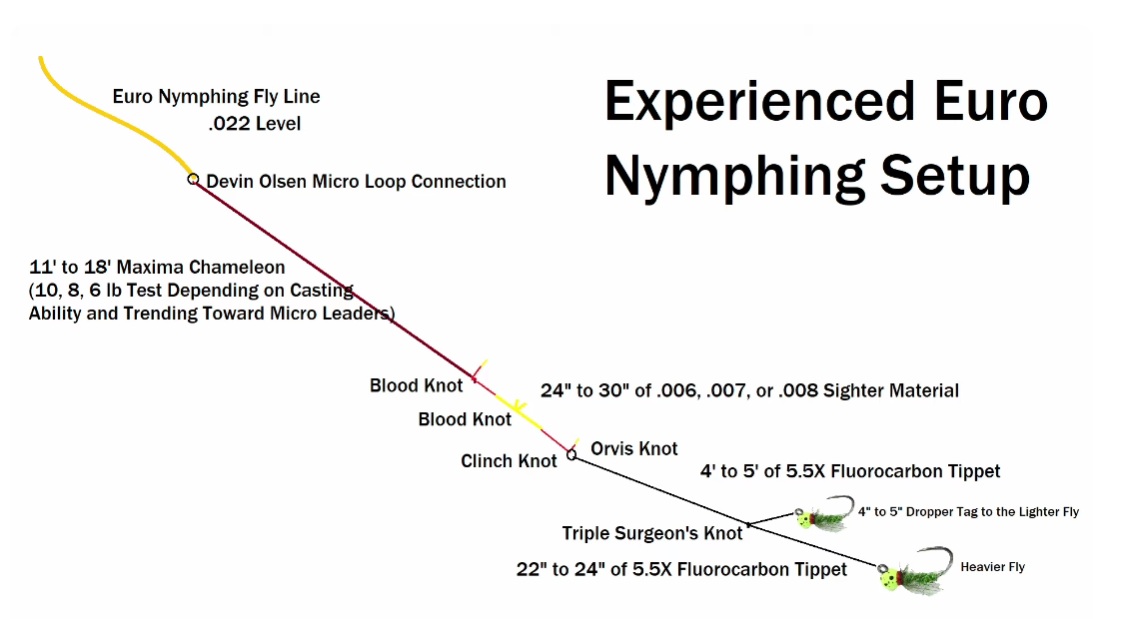
-From TroutFlies Tutorials
Recommended Gear For Euro Nymphing
Rod: Use a rod that is ideally Euro-specific, 9-10 feet in length, 3-4 weight, medium-fast action for delicate presentations, and power to manage currents.
Reel: Choose a large arbor reel, superb drag system is essential. No need for excess backing, focus on a smooth drag for catching fish.
Line: Special designed lines for Euro nymphing are ultra-lightweight, short (about 30-90 feet) and have a low diameter for minimum water resistance.
Leader: French Leader set-ups are preferable. They start thick (butt section) and taper down to a finer tippet.
Tippet: Start with 5X or 6X tippet material, 6-8 feet long, adjust the length based on water depth and conditions.
Flies: Use small, bead-head nymphs in sizes 14-18 such as Perdigons, Squirmy Worms, and Zebra Midges.
Two-Fly Setup: Fish two flies, one attached to the tippet and another one or two feet higher up the leader using a dropper tag.
Here’s the gear you’ll need for Euro nymphing, along with some specifics on what types are better suited for this technique:
Nymphing Rod
A Euro-specific rod is ideal, but not essential. These rods are typically:
- Length:9-10 feet
- Weight:3-4 weight
- Action: Medium-fast action. This provides a good feel for delicate presentations and enough power to handle currents.
Nymphing Reel
- A large arbor reel with a good drag system is ideal. You won’t be using a lot of backing, so focus on a smooth drag for playing fish.
Line
These are specialized lines designed for Euro nymphing. They are:
- Ultra-lightweight
- Short in length (around 30-90 feet)
- Low diameter for minimal water resistance
Leader
- French Leader: This is the heart of a Euro setup. You can buy pre-tied leaders or learn to tie your own. It typically consists of a butt section (thicker), followed by decreasing diameters down to a finer tippet.
Tippet:
- Start with 5X or 6X tippet material, 6-8 feet long. You can adjust the length based on water depth and conditions.
Flies:
- Euro Nymphs: Choose small, bead-head nymphs in sizes 14-18. Popular patterns include Perdigons, Squirmy Worms, and Zebra Midges.
- Two Fly Setup: A common Euro nymphing approach is to fish two flies. Attach one nymph directly to the tippet and another foot or two higher up the leader using a dropper tag.
Bottom Lines
In the end, we can say that Euro-nymphing is a particular fly-fishing technique and is most effective on deep, flowing currents.
Using a long sensitive leader, heavy flies as nymphs, and a tight line, the technique of Euro nymphing allows anglers to detect subtleties intakes and to present flies as naturally as possible.
Though it has a steeper learning curve compared to the regular techniques, it provides substantial advantages, especially when fishing in pressured waters. With the proper equipment and a little practice, one can perceive the success of euro nymphing and become a better flight fisher.


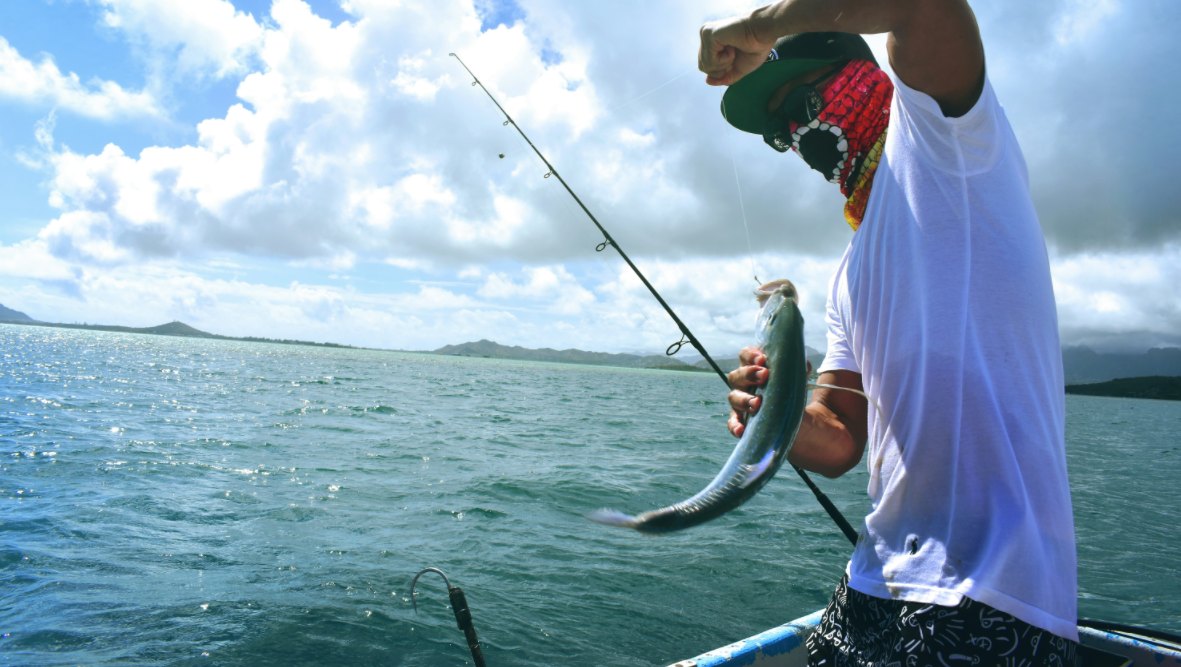






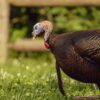
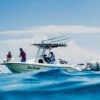









Leave a reply